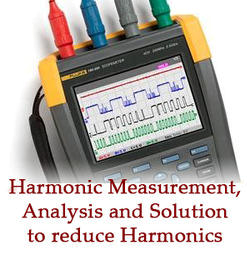




 Harmonic Study
Harmonic Study
Sachu Technologies offering Harmonic Study is carried out to check the Harmonic distortion levels in the network and to subsequently identify the Source of Harmonic distortion.
What are harmonics?
The term harmonics commonly refers to a distortion of the normally smooth utility power. Harmonics are actually higher frequency voltages and currents and when added to the utility power, produce a distortion of the normal voltage or current waveform. Usually, harmonic distortion must be present continuously to have an adverse effect on the power system.
 |
Initial rise to the highest point at the front is called a Transient Symptoms of Harmonics Studies
Causes of harmonics
Harmonics are produced by "non-linear" loads in power systems. A non-linear load does not draw current in proportion with the applied 60 Hertz sinusoidal voltage waveform. In other words, this equipment "gulps" electric current from the supply rather than taking current in a smooth fashion.
Harmonic-producing non-linear loads comes from devices with power electronics such as:
Symptoms of Harmonics
In small quantities, harmonics are of little concern. However, too many non-linear loads in your facility can lead to significant power quality problems. Main issues caused by Harmonics in the network systems
Effects of Harmonics:
Increased losses and temperature rise in Cables & Transformers.
Resonance between inductance and capacitance of the network resulting in amplification of harmonic currents in the network.
Accuracy of measuring instruments and protection relays affected .Communication signals distorted.Increase in Eddy Current and
Hysteresis Losses.Increase in Noise level of Audio equipment.Buss Bar Humming Noise
Increase in neutral currents.Neutral conductor and terminal failures.Failure of electromagnetic loads.Cards Failure
A Harmonic Study will:
In our Harmonic Analysis we measure and capture detailed harmonics, interharmonics and capacitor switching events to effectively troubleshoot the problems caused by resonance, and non-linear devices.
Eliminating Harmonics
While there are several products available on the market designed to deal with harmonics, each requires careful analysis to ensure proper application. Both passive and active harmonic filters can be applied in specific situations.
Passive harmonic filters are the most common and are always custom-designed for the application or site. Active harmonic filters are a relatively new technology that will gain market share quickly as their initial cost becomes competitive with the passive variety.
Total Harmonic Study (THD)
The total harmonic distortion, or THD, of a signal is a measurement of the harmonic distortion present and is defined as the ratio of the sum of the powers of all harmonic components to the power of the fundamental frequency.The Level of harmonic distortions is often used to define the degree of harmonic content in an alternating signal. The limits on Voltage harmonics are thus set at 5% for THD and 3%for any single harmonic .However keeping low THD values on a system will further ensure proper operation of equipment and a longer equipment life span
Harmonic Prevention and Reduction